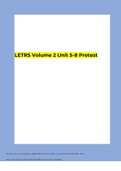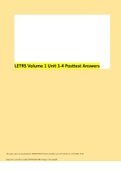LETRS Volume 1 Unit 1 4
Liberty University
All 3 results
Sort by

-
LETRS Unit 1-4 Pre & Post Test Questions and Answers/ Correctly solved
- Exam (elaborations) • 4 pages • 2023
- Available in package deal
-
- $11.49
- + learn more
1. Which statement best describes the relationship between reading compre- hension and word decoding in a beginning reader's development?: Accurate, fast word recognition is necessary for development of reading fluency and text comprehension. 2. Near the close of the day, a kindergarten teacher guides the students in conversation about the day's activities. She writes down what is said on large chart paper, then reads it to the class. This activity would aid their literacy development primar...

-
LETRS Unit 1 - 8 Assessments BUNDLED TOGETHER |Questions and Answers 2022/2023|Verified Answers
- Package deal • 15 items • 2023
-
- $36.49
- + learn more
Once students decode well, which statement describes the relationship between vocabulary and reading comprehension? Vocabulary is the best single predictor of reading comprehension. In teaching the word invisible, the teacher broke it into the parts in – vis – ible and talked about the meanings of the parts. Which aspect of language was emphasized?

-
LETRS Volume 1 Unit 1-4 Posttest Answers
- Exam (elaborations) • 7 pages • 2023
- Available in package deal
-
- $8.99
- 3x sold
- + learn more
Which statement best describes the relationship between reading comprehension and word decoding in a beginning reader’s development? Accurate, fast word recognition is necessary for development of reading fluency and text comprehension. Near the close of the day, a kindergarten teacher guides the students in conversation about the day’s activities. She writes down what is said on large chart paper, then reads it to the class. This activity would aid their literacy development primari...

Do you wonder why so many students wear nice clothes, have money to spare and enjoy tons of free time? Well, they sell on Stuvia! Imagine your study notes being downloaded a dozen times for $15 each. Every. Single. Day. Discover all about earning on Stuvia


